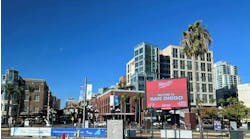The latest construction data from Dodge Data & Analytics revealed a big decrease in construction activity during August. It also highlighted the sharp divide between the local market areas enjoying a robust electrical construction market in 2021 and those metros battling adverse business conditions.
While Dodge’s year-to-date (YTD) total construction starts data through August is maintaining an 11% growth rate (due almost entirely to a 24% YTD increase in residential construction), the August monthly data showed a 9% decline in total construction starts to $782.84 billion and a 13% decline in nonresidential building starts. Residential building was down 9% to $370.12 billion.
In a press release announcing the August data, Richard Branch, chief economist for Dodge Data & Analytics, said, “Construction starts have hit a rough patch following the euphoria seen in the early stages of recovery from the pandemic… The Delta variant has raised concern that the fledgling economic recovery is stalling out, undermining the already low level of demand for most types of nonresidential buildings. Additionally, significant price increases for construction materials, logistic constraints, and labor shortages are making a challenging situation worse. Construction starts are likely to remain unsteady over the next few months. However, the dollar value of projects entering planning continues to suggest that the recovery in construction starts should resume early in the new year.”
Despite the slowdown in August, some fast-growing Metropolitan Statistical Areas (MSAs) continue to crush the U.S. averages for construction activity. Dodge recently released data for the 35 MSAs that by themselves account for an estimated 41% of all construction activity in the nation when ranked by billions of dollars of construction starts. The San Diego-Carlsbad, Calif., MSA posted 100% growth in total building starts over the past year due, in part, to a 200-acre project near California State University–San Marcos, which will include more than 600 homes and up to 1.7 million sq ft of commercial and retail space; a $475-million student housing project at San Diego State; and numerous large-scale urban renewal projects in downtown San Diego. Other MSAs seeing growth in total construction starts of more than twice the national average through August were the Denver-Aurora MSA (32%); Philadelphia-Camden-Wilmington MSA (31%); Miami-Ft. Lauderdale-Miami Beach MSA (30%); San Francisco-Oakland-Fremont MSA (29%); and Raleigh-Cary MSA (28%).
In the not-too-distant future, expect to see Memphis, Tenn., and Louisville, Ky., ranked among the fastest-growing metros, a result of Ford Motor Co.’s recent announcement that it will invest $11.4 billion in the construction of two factories in these areas to produce the next generation of its electric F-Series trucks and the batteries to power future electric Ford and Lincoln vehicles.
Wondering which local markets will have the most construction projects in 2022? The editors of Electrical Marketing newsletter, an EC&M sister publication, recently picked the 25 MSAs they expect to grow the fastest next year (see the Table below).
After analyzing key growth indicators, including electrical contractor employment, building permits, population growth, unemployment, and estimates for electrical sales through electrical distributors, the editors selected the MSAs that are trouncing the national averages for these indicators.
Most of the metros on the list are located in the Sunbelt; Florida boasts seven MSAs in the Top 25. The Northport-Sarasota-Bradenton MSA, Jacksonville MSA, and Tampa-St. Petersburg-Clearwater MSA led the parade in Florida. Look further down the ranking, and you will see Florida’s Gulf Coast is one of the fastest-growing regions in the United States, with the Cape Coral-Fort Myers, Crestview-Fort Walton Beach-Destin, Naples-Marco Island, and Punta Gorda MSAs making the list.
At the top of the list is a market area that comes up quite a bit in discussions about fast-growing cities – Austin, Texas. The Austin-Round Rock-Georgetown, Texas, MSA has attracted 292,489 new residents over the past five years. According to the U.S. Census Bureau’s latest population data, from 2019 to 2020 an estimated 146 people were moving to Austin every day. Market areas like Austin and the other MSAs in the table with impressive growth metrics prove that while the national economics typically provide a general idea of the health of the electrical construction market, some markets are always outpacing or underperforming the national averages.
Interested in finding out which other local market areas are growing fast? As part of a $99 annual subscription, Electrical Marketing newsletter offers 24/7 online access to regularly updated economic indicators at the county, MSA, state, and national levels. For more information contact Jim Lucy, Editor-in-Chief, Electrical Marketing, at [email protected].






